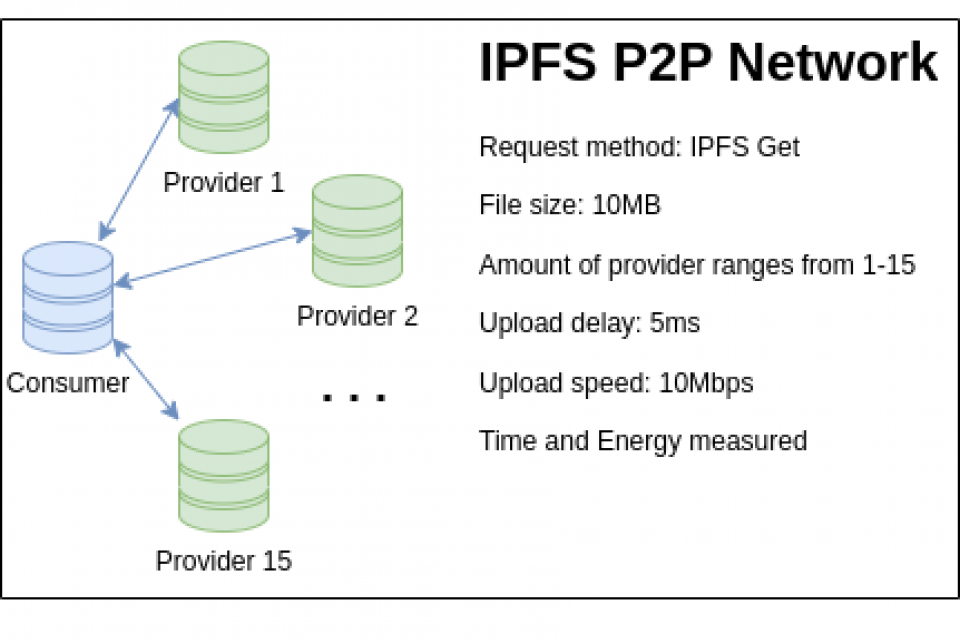Datasets
Standard Dataset
Time and Energy Measurement with IPFS
- Citation Author(s):
- Submitted by:
- Paul Schwenteck
- Last updated:
- Mon, 08/05/2024 - 08:38
- DOI:
- 10.21227/g5x9-jc97
- Data Format:
- License:
 106 Views
106 Views- Categories:
- Keywords:
Abstract
This dataset presents a comprehensive collection of measurements obtained from a self-made test bed called the NET Playground, focusing on the performance evaluation of an IPFS (InterPlanetary File System) consumer and multiple providers. The dataset comprises 45 sets of data, each representing a scenario involving the consumer requesting a 10MB file from a varying number of available providers ranging from 1 to 15. The network configuration involves all nodes (consumer and providers) being connected in a peer-to-peer network and utilizing IPFS as the communication protocol. The upload delay of each node is fixed at 5 ms, and the upload speed is set to 10 Mbps. The dataset provides valuable insights into download time and energy consumption for the consumer and the provider in an IPFS environment. Researchers can utilize this dataset to analyze and optimize the network performance and energy efficiency of IPFS systems.
# Dataset Documentation:
## Overview:
This dataset contains measurement data obtained from the NET Playground test bed, focusing on the performance evaluation of an IPFS (InterPlanetary File System) consumer and multiple providers. The dataset consists of 45 runs, numbered from 0 to 44, with each run representing a unique scenario. The measurements include download time and energy consumption for various configurations of available providers in the network.
## Directory Structure:
The dataset is organized into directories based on the run number, ranging from 0 to 44. Each run directory contains the measurement data for download time and energy consumption.
## Download Time Data:
The download time data is stored in separate text files named "time_x.txt," where 'x' represents the number of available providers in the network, ranging from 1 to 15. Each time file contains three timestamps measured in seconds. The first timestamp indicates the beginning of the IPFS procedure to retrieve the requested file. The second timestamp signifies when the consumer has finished downloading the content and stored it to the disk. The third timestamp represents the completion of the experiment, including device resetting and preparation for the next measurement.
## Energy Consumption Data:
The energy consumption data is stored in CSV format files named "energy_x.csv," corresponding to the number of available providers 'x.' Each energy file contains three columns of data. The first column represents the timestamp of the measurement. The second column represents the current level in Amp of the consumer device during the measurement. The third column indicates the average current level in Amp from all available providers in the network during the same measurement.
## Data Format:
Download Time files: Text files (.txt) with three timestamps per line: start ipfs, end ipfs, end run.
Energy Consumption files: CSV files (.csv) with three columns: timestamp, consumer current level, and average current level from providers.
## Dataset Usage:
Researchers and practitioners can utilize this dataset to analyze and evaluate the performance of IPFS networks in terms of download time and energy consumption. The dataset provides valuable insights into the impact of the number of available providers on these metrics. Researchers can explore optimization strategies, compare different provider configurations, and analyze the energy efficiency of IPFS systems.
## Acknowledgements:
Funded in part by the German Research Foundation (DFG, Deutsche Forschungsgemeinschaft) as part of Germany’s Excellence Strategy – EXC 2050/1 – Project ID 390696704 – Cluster of Excellence “Centre for Tactile Internet with Human-in-the-Loop” (CeTI) of Technische Universität Dresden as well as by the German Research Foundation (DFG, Deutsche Forschungsgemeinschaft) under Project ID 450566247 and the Federal Ministry of Education and Research of Germany in the programme of “Souverän. Digital. Vernetzt.” – Joint project 6G-life – projectID: 16KISK001K and 16KISK002
Documentation
| Attachment | Size |
|---|---|
| 3.02 KB |






